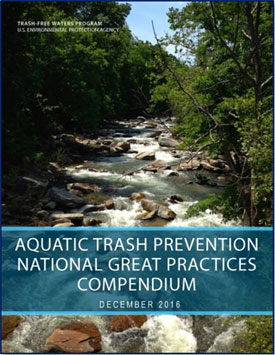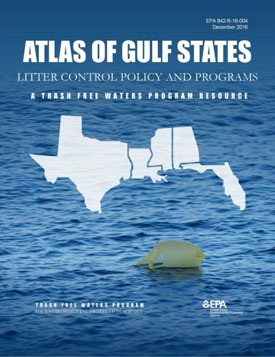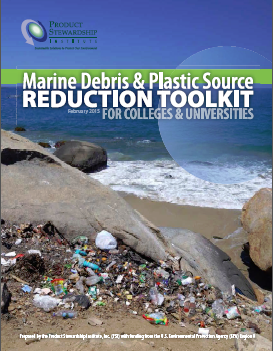Best Management Practices & Tools
- EPA's Forthcoming Escaped Trash Assessment Protocol (ETAP)
- National Great Practices Compendium
- Atlas of Gulf States Litter Control Policy and Programs
EPA seeks to share effective best management practices, policies and programs that reduce the overall volume of trash that generated or prevent trash from entering the aquatic environment.
EPA's Forthcoming Escaped Trash Assessment Protocol (ETAP)
Coming soon: EPA’s Escaped Trash Assessment Protocol!
The forthcoming Escaped Trash Assessment Protocol (ETAP), developed by the U.S. Environmental Protection Agency's Trash Free Waters program, is a quantitative survey tool which provides a standard method for collecting and assessing litter data.
The protocol is designed to be applied to a broad range of site types— e.g., parks, streets, parking lots, etc. — and environmental conditions — e.g., various hydrological and climatic regimes. This universally accessible and applicable method for trash monitoring will provide practitioners and citizen scientists with a comprehensive and rigorous method for quantifying trash loadings. The tool can also be used to assess item age and level of fouling and analyze and compare across specific material types and categories of trash collected. This information can eventually be used to guide upstream source reduction decisions.
Please look back here for the official ETAP reference manual and field data card.
National Great Practices Compendium
 Download the ReportThe National Great Practice Compendium highlights outstanding activities, technologies, and programs that prevent trash from entering the aquatic environment and/or reduce the overall volume of trash that is generated.
Download the ReportThe National Great Practice Compendium highlights outstanding activities, technologies, and programs that prevent trash from entering the aquatic environment and/or reduce the overall volume of trash that is generated.
An activity qualifies as a Great Practice if it achieves measurable progress towards its trash prevention and/or reduction goals and shows a clear return on investment from such efforts. Results must be measurable and achievable.
This compendium serves as a reference tool for Great Practices that show real results. The Trash Free Waters program developed this resource after hearing from many stakeholders that they needed better information on “what works.” The Great Practices that are highlighted can help civic leaders and others make informed decisions about their future trash prevention program investments based upon the successes of others.
Atlas of Gulf States Litter Control Policy
and Programs
 Download the ReportThe Gulf Atlas is a compendium of state and local policies and programs that reduce and prevent aquatic trash, as well as the related enforcement mechanisms that support them.
Download the ReportThe Gulf Atlas is a compendium of state and local policies and programs that reduce and prevent aquatic trash, as well as the related enforcement mechanisms that support them.
The Trash Free Waters program developed the Gulf Atlas to address a strong stakeholder request for information on programs that are addressing this issue.
The Gulf Atlas facilitates collaboration and information-sharing among state and municipal governments and other interested groups.
Marine Debris Campus Toolkit
 Download the Marine Debris & Plastic Source Reduction Toolkit for Colleges & Universities
Download the Marine Debris & Plastic Source Reduction Toolkit for Colleges & Universities
EPA, the Product Stewardship Institute, and the University of California collaborated on a Marine Debris & Plastic Source Reduction Toolkit for Colleges & Universities to help college campuses and other institutions cut their plastic waste, to help reduce marine debris and coastal pollution. The toolkit, funded by an EPA grant, resulted from a successful two-year pilot project by the Product Stewardship Institute at three coastal University of California campuses: UC Santa Barbara, UC San Diego, and UC San Francisco.
During the two-year project, all three UC campuses dramatically reduced their consumption of plastics. UC Santa Barbara saw a 97% decline in plastic bag use by campus food services through an agreement with their local Subway store to eliminate unnecessary packaging. By promoting campus hydration stations, the campus also eliminated over 60,000 single-use plastic water bottles. UC San Diego reduced plastic bag use by more than a million bags each year, working with their campus Subway restaurant to eliminate plastic bags and straw sleeves. UC San Francisco’s Parnassus and Mission Bay campuses retrofitted more than 50 water fountains with gooseneck spouts to fill reusable water bottles, cutting campus purchasing of single-use plastic water bottles by 50%, and saving $27,500 each year.
- A Footprint Calculator to determine a campus’ "plastic footprint"
- A source reduction plan to eliminate the use of disposable plastic items
- Changing campus purchasing practices by switching to greener, lower-waste products, and
- Establishing campus-wide plastic waste reduction policies.
